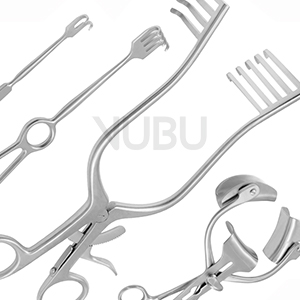Surgical retractors are indispensable tools in operative medicine, specifically designed to retract tissue and provide a clear view and sufficient space for surgical procedures. They come in a variety of shapes and sizes to meet the diverse demands of surgery, traumatology, and dermatology.
Blunt retractors are particularly common, as they protect surrounding tissue and minimize injuries. A special variant is the self-retaining retractor, which features an integrated locking mechanism that prevents the retracted tissue from closing back once the arms are spread apart. This allows for efficient and hands-free operation in the surgical field.
Abdominal retractors are another important category of surgical instruments. They are specifically designed to stretch the abdominal wall horizontally or vertically, creating a large and clear surgical field. This is particularly crucial for abdominal surgical procedures.
Other instruments in this category include:
Abdominal spatulas: Ideal for treating deep wounds or abdominal procedures, allowing precise holding or shifting of tissue.
Fine retractors: Perfect for minimally invasive procedures or delicate surgical work where careful tissue management is required.
Advantages of Surgical Retractors:
Precision: Enables accurate and controlled retraction of tissue.
Tissue Protection: Blunt versions minimize the risk of tissue damage.
Efficiency: Self-retaining retractors allow for hands-free operation, increasing efficiency in the OR.
Versatility: Available in various sizes and designs to meet different surgical needs.
Areas of Application:
General Surgery: For tissue dissection and creating surgical fields.
Orthopedics: For exposing bones and joints.
Dermatology: For treating skin lesions and wounds.
Gynecology and Urology: For abdominal and pelvic procedures.
Why Are Surgical Retractors So Important?
Surgical retractors are essential tools for surgeons, as they not only improve access to the surgical field but also enhance precision and safety during procedures. Their versatile applications and high functionality significantly contribute to the success of surgeries.
Tips for Selection and Handling:
Choose the right retractor based on the type of procedure and the size of the surgical field.
Opt for high-quality materials such as stainless steel, which is durable, easy to clean, and autoclavable.
Regularly check the functionality of the instruments, especially self-retaining retractors, to ensure reliable performance.
Conclusion:
Surgical retractors, self-retaining retractors, and abdominal retractors are essential instruments in modern surgery. They enable safe, precise, and efficient procedures, thereby improving patient care. Invest in high-quality instruments to enhance the quality of your surgical interventions.
Retractors form a diverse group of surgical instruments designed to maintain or create access to the surgical field during a procedure. These instruments are indispensable in surgery, orthopedics, and other medical fields to ensure precision, safety, and efficiency during operations.
Retractors: Variety and Applications
Retractors come in various shapes and sizes to handle different tissues and anatomical structures:
Blunt and rounded variants: These are used to retract sensitive tissues and organs such as the intestines, liver, and lungs without causing injury. Well-known examples include the Roux retractor, the Langenbeck retractor, and the Fritsch retractor.
Sharp and pointed variants: Also known as "single-prong" or multi-pronged "sharp retractors", these are used to precisely separate less sensitive connective tissue.
Specula: For Natural Body Openings
Specula are specialized instruments used to hold open natural body openings such as the vagina, anus, nose, or ear canal. Some specula feature a spreading mechanism (e.g., the Parks anal retractor) or an integrated light source to ensure clear visibility into the depth of the body cavity. A key example is the laryngoscope, used in anesthesia and ENT surgery.
Wound Spreaders: Precision and Stability
Wound spreaders, such as the rib spreader, use a ratchet system to variably widen the wound as needed. They passively keep the access path open after engagement, allowing the surgeon to work hands-free. These instruments are particularly useful in thoracic surgery or other procedures requiring stable access.
Orthopedics and Trauma Surgery: Levers and Forceps
In orthopedics and trauma surgery, levers and forceps are used to facilitate access to bones and maintain a reduced bone fracture in the correct position until the completion of osteosynthesis. Typical examples include the Hohmann lever and the Verbruegge forceps, known for their durability and precision.
Modern Retractor Systems: Efficiency and Comfort
In the past, larger surgeries were often performed by a surgeon and two assistants, with the second assistant responsible for holding the surgical field open using retractors. Today, rigid holders are increasingly used, allowing retractors to be attached in various positions. These retractor systems offer several advantages:
Hands-free operation: Surgeons can focus entirely on the procedure.
Precise positioning: Retractors can be adjusted and fixed accurately.
Time-saving: Faster and more efficient work in the OR.
Why Are Retractors So Important?
Retractors are indispensable tools in surgery, as they not only improve access to the surgical field but also enhance safety and precision during procedures. Their versatile applications and high functionality significantly contribute to the success of surgeries.
Tips for Selection and Handling:
Choose the right retractor based on the type of procedure and the anatomical structure.
Opt for high-quality materials such as stainless steel, which is durable, easy to clean, and autoclavable.
Regularly check the functionality of the instruments, especially mechanical retractor systems, to ensure reliable performance.
Conclusion:
Retractors, wound hooks, wound spreaders, and specula are essential instruments in modern surgery. They enable safe, precise, and efficient procedures, thereby improving patient care. Invest in high-quality instruments to enhance the quality of your surgical interventions.
